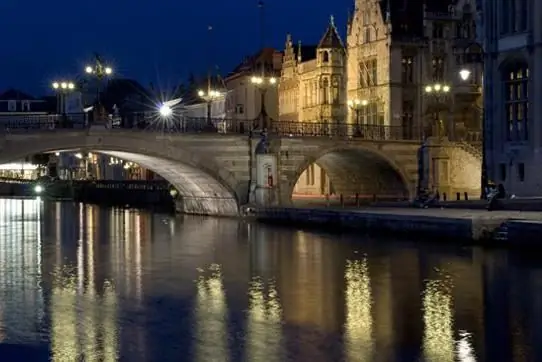- Author Harold Hamphrey [email protected].
- Public 2023-12-17 10:06.
- Last modified 2025-01-24 11:10.
Humanity is distributed over the earth's surface extremely unevenly. In order to be able to compare the degree of population of different regions, an indicator such as population density is used. This concept connects a person and his environment into a single whole, is one of the key geographical terms.
Population density shows how many people there are per square kilometer of area. Depending on specific conditions, the value may vary greatly.
The average world population density is about 50 people/km2. If we do not take into account the ice-covered Antarctica, then it will be about 56 people / km2.
World population density
Humanity has long been more actively populated areas with favorable natural conditions. This is a flat terrain, a warm and fairly humid climate, fertile soils, and the availability of sources of drinking water.
In addition to natural factors, the history of development and economic reasons influence the distribution of the population. Territories inhabited by man earlier are usually denser than areas of new development. Where labor-intensive branches of agriculture or industry develop, the population density is greater. "Attract" people and developed deposits of oil, gas, other minerals, transport routes: railways and roads, navigable rivers, canals, coasts of non-freezing seas.
The actual population density of the countries of the world proves the impact of these conditions. The most populous are small states. Monaco can be called the leader with a density of 18680 people/km2. Countries such as Singapore, M alta, Maldives, Barbados, Mauritius and San Marino (7605, 1430, 1360, 665, 635 and 515 people/km2 respectively), apart from favorable climate They also have an exceptionally convenient transport and geographical position. This led to the flourishing of international trade and tourism in them. Bahrain stands apart (1720 people/km2), developing due to oil production. And the Vatican, which is in 3rd place in this ranking, has a population density of 1913 people / km2 not due to the large number, but a small area, which is only 0.44 km 2.
Among large countries, Bangladesh has been the leader in terms of population density for a decade (about 1200 people/km2). The main reason is the development of rice cultivation in this country. This is a very labor-intensive industry, so it requires a lot of hands.

The most "spacious" territories
If we considerdensity of world population by country, another pole can be distinguished - sparsely populated areas of the world. Such territories occupy more than ½ of the land area.
Rare is the population along the shores of the Arctic seas, including the subpolar islands (Iceland - a little over 3 people/km2). The reason is the harsh climate.
Poorly populated desert areas of North (Mauritania, Libya - a little more than 3 people / km 2) and South Africa (Namibia - 2.6, Botswana - less than 3.5 people/km2), Arabian Peninsula, Central Asia (in Mongolia - 2 people/km2), Western and Central Australia. The main factor is poor hydration. With enough water, the population density immediately increases, as can be seen in the oases.
Uninhabited areas include rainforests in South America (Suriname, Guyana - 3 and 3.6 people/km2 respectively).
And Canada, with its Arctic archipelago and northern forests, has become the most sparsely populated among the giant countries.
There are no permanent residents at all on the whole mainland - Antarctica.
Regional differences
The average population density of the countries of the world does not give a complete picture of the distribution of people. Within countries there can be significant differences in the degree of development. A textbook example is Egypt. The average density in the country is 87 people/km2, but 99% of the inhabitants are concentrated in 5.5% of the territory in the Nile Valley and Delta. In desert areas, there are several square kilometers for each person.
In southeastern Canada, density may be higher100 pax/km2 and less than 1 pax/km in Nunavut2.
There is an order of magnitude greater difference in Brazil between the industrial southeast and the hinterland of the Amazon.
In highly developed Germany there is a cluster of population in the form of the Ruhr-Rhine region, in which the density is more than 1000 people/km2 , and the national average is 236 people/km 2. This pattern is observed in most large states, where natural and economic conditions differ in different parts.
How are things in Russia?
Considering the density of the world's population by country, one cannot ignore Russia. We have a very large contrast in the placement of people. The average density is about 8.5 persons/km2. This is 181 places in the world. 80% of the country's inhabitants are concentrated in the so-called Main Settlement Zone (south of the Arkhangelsk-Khabarovsk line) with a density of 50 people/km2. The strip covers less than 20% of the territory.

The European and Asian parts of Russia differ sharply. The northern archipelagos are almost uninhabited. You can also name the vast expanses of the taiga, where hundreds of kilometers can be from one dwelling to another.
Urban agglomerations
Usually the density is not that high in rural areas. But large cities and agglomerations are places of extremely high concentration of the population. This is due to high-rise buildings, and a huge number of enterprises and jobs.

The population density of the world's cities also varies. Tops the list of the "closest" agglomerations of Mumbai (more than 20 thousand people per sq. km). In second place is Tokyo with 4400 people/km2, in third place are Shanghai and Jakarta, second only slightly. The most populous cities also include Karachi, Istanbul, Manila, Dhaka, Delhi, Buenos Aires. Moscow is on the same list with 8000 people/km2.

You can clearly imagine the population density of the countries of the world not only with the help of maps, but also with night photographs of the Earth from space. The underdeveloped territories on them will remain dark. And the brighter the area on the earth's surface is illuminated, the denser it is populated.






